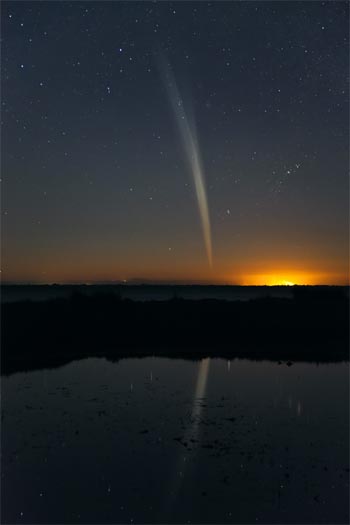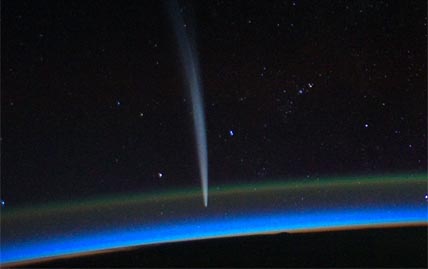As 2011 draws to a close, a comet that hadn't even been discovered a month ago is emerging as the celestial sensation of the year. NASA's Kepler spacecraft might be redefining how we view extrasolar planets, but Comet Lovejoy (C/2011 W3) likewise has forever altered our notion of what happens to comets as they near the Sun.
This 11th-hour interloper not only survived its December 16th perihelion (a scorching 116,000 miles from the Sun's surface), but in the days afterward it also held together and reformed its dust and gas tails. Armchair astronomers around the world watched anxiously as the comet distanced itself from the Sun in image sequences taken by orbiting spacecraft. And for those lucky enough to live deep in the Southern Hemisphere, viewing vicariously was soon no longer necessary.

Picture-perfect Comet Lovejoy (C/2011 W3) hangs in the predawn sky over Mandurah Estuary near Perth, Australia. Photographer Colin Legg captured the comet and its reflection on December 22, 2011, in a 13-second exposure with a 70-mm f/4 lens at ISO 3200. Click on the image for a larger view, and click here for his video of the comet rising into view one day earlier.
Colin Legg
Barely a day after perihelion, discoverer Terri Lovejoy managed to snap images of his namesake in daylight, when he estimated its brightness at roughly -1 in magnitude. Its brightness has fallen off somewhat in the days since, to perhaps 4th magnitude, but many observers now report being able to see Comet Lovejoy with unaided eyes in the predawn sky, its tails stretching upward into Scorpius. As of this morning the comet's nucleus was about 17° from the Sun, an elongation that will grow rapidly to 24° by Christmas Day and 40° by New Year's Eve.
"At long last the skies are clear in the Canberra region," reported Australian observer Dave Herald earlier today. "The nucleus for Lovejoy doesn’t rise for another half hour. But already the tail is visible to the naked eye, extending a full 10° above the horizon. The surface brightness is similar to the Magellanic clouds — even though they are higher in the sky."
Watching and photographing the comet from New Zealand's North Island, Ian "Coops" Cooper noted, "We always knew that this would be the day. Once the coma cleared the brighter part of astronomical twilight, we were in with a grin. Tail now out to 18°!" — and here is his proof!
Meanwhile, members of Brazil's Grupo Nevoeiro astronomy club scrambled to find a dark-sky site outside the city of Curitiba. Fernando Lopes managed to capture several images in the growing twilight that revealed Comet Lovejoy's thin gas tail. "Wonderful show — unforgettable moment," he exults.

Astronaut Dan Burbank captured Comet Lovejoy from the International Space Station on December 21, 2011. Despite setting his Nikon D3S to an ISO of 12800, he still needed a steady hand for this 0.8-second exposure through an f/2.8 lens. The greenish ribbon, above the blue twilight band hugging Earth's limb, is airglow from oxygen atoms about 60 miles (100 km) up. Click on the image for the original, high-resolution view.
NASA / D. Burbank
In fact, the comet has now been viewed by observers with arguably the best-possible vantage: the International Space Station. Yesterday, ISS commander Dan Burbank captured a view of the comet rising from the color predawn twilight and airglow hugging Earth's limb. He posted a quick view of his snapshot via Twitpic, and within the hour NASA has released the full-resolution view. What a sight!
All the excitement over Comet Lovejoy has almost — but not quite — caused me to forget that we northern skywatchers are once again relegated to the sidelines by a wonderful "broom star" gracing southern skies. It's been five years, but I'm still grouchy that I didn't get to view Comet McNaught, C/2006 P1, in all its feathery glory. (So too is my science-writing colleague Daniel Fischer, who's still steamed that NASA managers didn't send the Space Station crew a head's up about that gorgeous cosmic visitor.)
Well, I can always dream: Seiichi Yoshida's list of future visual comets hints that one of PanSTARRS's comets, C/2011 L4, could conceivably blaze to magnitude 0 when it peaks in mid-March 2013. For those who care, that's just 448 days from now!
 6
6









Comments
Les Dalrymple
December 22, 2011 at 6:17 pm
I observed this comet for the first time today (23rd December) about 120km south of Sydney, Australia and it is a brilliant object. The tail approaches 15-20 degrees and looks like a distant searchlight beam rising out of the sea as the comet ascends the morning sky. The visible tail has better surface brightness than much of the southern Milky Way. I rate it as very nearly on par in brightness at C/2006 P1 McNaught. I don't remember Ikeya-Seki in 1965 (I was 3 years old at the time ...), but, from the descriptions of it, C/2011 W3 Lovejoy is very similar.
In my opinion this rates as a great comet. I propose the name "The Great 2011 Christmas Comet."
Best,
Les Dalrymple
Former Contributing Editor Sky & Telescope Magazine
Current Contributing Editor, Australian Sky & Telescope Magazine.
You must be logged in to post a comment.
Geoff
December 23, 2011 at 3:33 pm
I could not even call myself an amateur astronomer because I do not spend much time looking through my scope, but good article especially our about our luck in viewing such spectacular comets from the northern latitudes (Chicago).
You must be logged in to post a comment.
Michael C. Emmert
December 23, 2011 at 4:40 pm
To have survived tidal forces this far into the Sun's Roche limit, this must have been a solid object. That's quite a mystery all by itself. It would just about have to mean that the original Kreutz object was large enough to have differentiated, i.e. melted and the rock and iron separated out and sunk to the center.
An alternative theory would be the comet orbiting just outside the Roche limit and eventually melting from sunlight, and then mysteriously changing it's orbit to the present grazing orbit. Not likely.
This will cause head-scratching for years...
You must be logged in to post a comment.
Damien Lemay
December 23, 2011 at 7:58 pm
I understand that Lovejoy comes from very far (aphelion somewhere in the Oort cloud) and passing so close to the sun surface means is should have been speeding close to the scape velocity of the sun, which is 617.5km/sec. This is certainly the fastest thing we ever saw in the solar system. I would appreciate if someone could tel us the exact speed it reached when closest to the sun.
Thanks (Quebec)
You must be logged in to post a comment.
GlennHughes
December 24, 2011 at 8:34 pm
Saw the comet 4 to 4.45am from 20 km north of Canberra on the 24th. Along with a Saturn-Spica pairing, ruddy Mars, satellites galore and a brilliant sporadic flashing from Sirius to Canopus. Back in Sydney this morning and skies again clear but light pollution from the 2 million people East of me washing the comet out compared to the countryside view. This apparition looks to be fantastic for observers down under as was MacNaught so sympathies to all the northern hemisphere viewers. At only 2 degrees from the SCP we will get the windmill blade timelapse effect as occured at the NCP with Hale Bopp ?? or Hayakutake in 1997. Cheers.
PS I too missed Ikeya Seki - as a 10 yo I got up too late. Still in the same street to walk over the hill for a better aspect!
You must be logged in to post a comment.
Kevin Heider
December 28, 2011 at 7:07 am
Lovejoy did not come from the Oort Cloud on the 2011 perihelion passage. The current best-fit (based on an observation arc of 29 days) is that Lovejoy was at aphelion 150.5AU from the Sun in 1684.
You must be logged in to post a comment.
You must be logged in to post a comment.